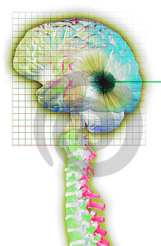Ground breaking surgery "eliminates" neuro-illnesses


Deep brain stimulation (DBS) is an experimental development used by neurologists and neuroscientists to counteract the damaged synpases in the brain, which give the effect of curing some neurological conditions such as Parkinson's disease, dystonia and Tourette's syndrome. The effects of this technology has been hailed as "marking the beginning of a revolution in psychiatric and neurological treatment".
On a side note, from my understanding of neurosciences research over the years (see the biography), neurological conditions are those which "can't be helped" - Parkinson's being a good example, where the patient suffers uncontrollable muscle spasms and shakes which they have absolutely no control of. These are hard-wired conditions which are biological and physically exist, in comparison to psychological illnesses which can be manipulated by a third-party - a psychologist, for example. Also, to put into some context, it is believed psychological illnesses cannot be cured one-hundred per cent whereas neurological illnesses can be; the difficulty exceeds those of curing psychological illnesses due to the inability to explore the physical brain.
This is how it works. Two probes are entered into a specific area of the subthalamic nucleus and in the internal pallidum which is part of the basal ganglia - very deep inside the brain, almost level with where your eyes and ears meet if the lines crossed over in the center. These probes have fork-like endings which increase the surface area on the brain which gives better target accuracy without the need to re-perform surgery. The probes are fed underneath the skin, behind the spine and connect to a nuclear-battery powered neurostimulator or "pacemaker". The pacemaker often sits in the clavicle: the empty area just beneath your shoulder in your collarbone.
This essentially feeds an electric current deep into the brain, pulsing dozens if not hundreds of times a second, stimulating a part of the brain which counteracts the effects of certain neurological conditions. If surgery is successful, by turning on and off the pacemaker, the patient can turn on and off their condition.
For those with neurological conditions which are constantly apparent, such as Parkinson's, the patient is kept awake during the surgery which can last a few hours, to physically test the patient to see if their symptoms subside or not.
Wikipedia, helpfully, explains how DBS works:
"It has been shown in thalamic slices from mice that DBS causes nearby astrocytes to release adenosine triphosphate (ATP), a precursor to adenosine (through a catabolic process). In turn, adenosine A1 receptor activation depresses excitatory transmission in the thalamus, thus causing an inhibitory effect that mimics ablation or 'lesioning'."
The truth of the matter, after speaking to a number of neurosurgical consultants during my own consultations, is that they don't quite know why it works - they just know that it does. They have a number of theories and have done extensive studies and research over a number of years, to ensure that long term usage of DBS doesn't cause adverse effects later on in life.
For dystonia or Tourette's sufferers, such as myself, having the surgery is one step towards success. Over the course of a few months, using a wireless transmitter which, when used is held over the skin where the pacemaker lies, the modulation, voltage and the "on/off" switch can be used. In some cases, the pacemaker can be fitted with a cellular transmitter so doctors working at the hospital 100 miles down the road can remotely alter your pacemaker's settings if the current configuration does not have the desired effect.
This example shows the effects of when DBS is turned on, off, then on again. The man in this video starts mid-way through, and appears to suffer from Parkinson's disease. As he sits down, he disables the DBS using the wireless transmitter and the effects of his condition appear instantly. When he enables it again, within a second or two every symptom of uncontrollable shaking disappears.
Check this. Forget the language barrier, just watch:
DBS is risky, and involves invasive brain surgery. Not everybody with neurological illnesses such as the aforementioned are suitable for DBS, and even if the surgery goes ahead, there is no guarantee that the patients' symptoms will subside entirely, if at all. In some cases, the doctors have told me, it can exacerbate symptoms when disabled.
However, it has been proven to work on occasion, roughly 50% of the time with Tourette's sufferers, even though the number of successful operations carried out worldwide still run in two-figures. The other uses for this surgery have advanced research beyond copeable levels, with it being a possible gateway to a number of other illnesses which have doctors stumped.
My job here is not only to bring you the news of emerging and developing technology, but it's also to try them out and see what it can bring the next generation. If someone sends me a device to play with, I'll play with it, then write about it if I do so choose. With this, I can't really just "pop down to the hospital" and try it out... or can I? Hat tip to the first person who works that one out.